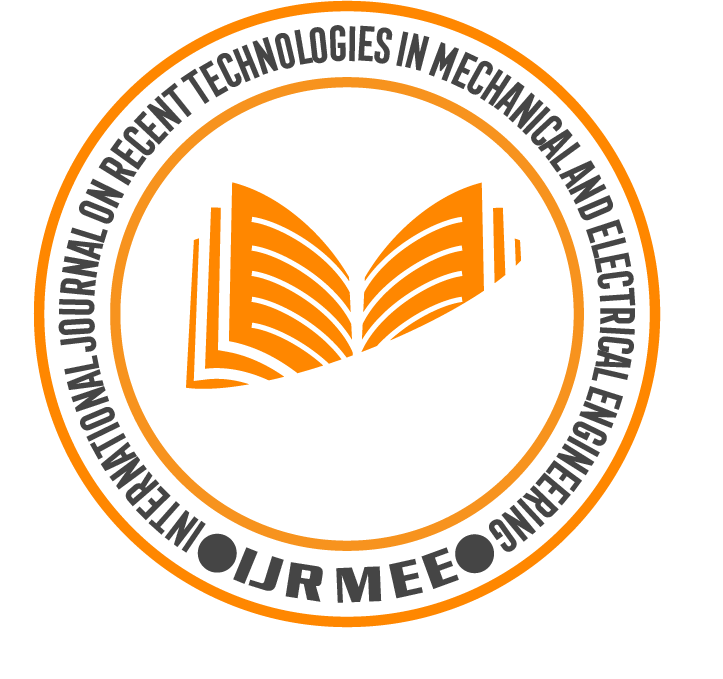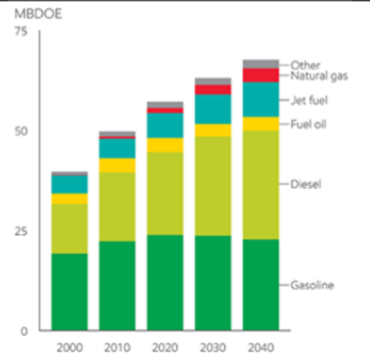A Review on Artificial Neural Network and Alternative Fuels for Internal Combustion Engines
Main Article Content
Abstract
Internal combustion engines are extensively used in energy generation and all transportation methods for people and goods. So, the demand of fuels used in IC engines has largely increased. The need of liquid fuels reaches to 3000 million tons oil equivalent per year and they are the cause of 10% of the world’s greenhouse emissions [1]. Our need for transport energy (IC engines) increases rapidly for both SI (passenger cars) and CI (commercial road transport and marine sectors) engines. This increase is predicted to reach about 40% in 2040 depending on 90% petroleum based liquid fuels, 5% natural gas. Now, the main development in petrol engines is to reach maximum performance while in diesel engines is to reduce soot and NOx emissions without affecting efficiency [2]. Internal combustion engines can be classified to spark ignition engines that use gasoline fuel where fuel-air are mixed before ignition and then combustion occurs, and compression ignition engines that uses diesel as a fuel that is compressed and injected so it reaches to self-ignition temperature. But at these days, there are many alternative fuels used instead of gasoline and diesel fuels such as ethanol, natural gas, liquefied petroleum gas, coal-derived liquid fuels, hydrogen, biodiesel, fuels other than alcohol, derived from biological materials, and non-petroleum fuels. Global transportation need of fuels is as in Figure 1. This indicates that biofuels reach 3% of the total fuel consumed in transportation sector [3]. These alternative sources reduce emissions and Sulphur contents [4]. Fuels of internal combustion engines in the general can be classified as shown in Figure 2. that indicates all types of conventional and alternative fuels [5]. In the last years, internal combustion engines have been controlled by artificial neural network as this method has various advantages, they can save time and money. This method is used to give us an indication about performance, combustion, and emissions. The purpose of the study is to look into the network topologies used to design the model, followed by a statistical analysis of the created ANN models. Also provided is a comparison of the ANN model and other prediction models [6].
Article Details
References
R. D. Reitz et al., “IJER editorial: The future of the internal combustion engine,†International Journal of Engine Research, vol. 21, no. 1, pp. 3–10, 2020, doi: 10.1177/1468087419877990.
G. T. Kalghatgi, “The outlook for fuels for internal combustion engines,†International Journal of Engine Research, vol. 15, no. 4, pp. 383–398, 2014, doi: 10.1177/1468087414526189.
C. Bae and J. Kim, “Alternative fuels for internal combustion engines,†Proceedings of the Combustion Institute, vol. 36, no. 3, pp. 3389–3413, 2017, doi: 10.1016/j.proci.2016.09.009.
N. Ghazaly and M. Salah Hofny, “Injection and Combustion of biodiesel at different blends: A review,†SVU-International Journal of Engineering Sciences and Applications, vol. 3, no. 2, pp. 37–46, 2022, doi: 10.21608/svusrc.2022.130956.1043.
E. Requirement, “Fuels for internal combustion engines 1.,†no. 2014, 2016, doi: 10.1002/0471238961.koe00016.
A. Narayan and B. Nitin, “Application of Artificial Neural Network for Internal Combustion Engines : A State of the Art Review,†Archives of Computational Methods in Engineering, vol. 29, no. 2, pp. 897–919, 2022, doi: 10.1007/s11831-021-09596-5.
T. J. Wallington, E. W. Kaiser, and J. T. Farrell, “Automotive fuels and internal combustion engines : a chemical perspective,†no. 1974, pp. 335–347, 2006, doi: 10.1039/b410469m.
Z. Wang, H. Liu, and R. D. Reitz, “Knocking combustion in spark-ignition engines,†Progress in Energy and Combustion Science, vol. 61, pp. 78–112, 2017, doi: 10.1016/j.pecs.2017.03.004.
A. J. M. Novak and P. N. Blumberg, “Parametric Simulation of Significant Design and Operating Alternatives Affecting the Fuel Economy and Emissions of Spark-Ignited Engines Parametric Simulation of Significant Design and Operating Alternatives Affecting the Fuel Economy and Emissions of Spa,†vol. 87, pp. 3485–3511, 1978.
“ON THE EMISSIONS FROM INTERNAL-COMBUSTION ENGINES : A RE » IE ¼,†vol. 513, no. February 1997, pp. 483–513, 1998.
J. Hou, X. Qiao, Z. Wang, W. Liu, and Z. Huang, “Characterization of knocking combustion in HCCI DME engine using wavelet packet transform,†Applied Energy, vol. 87, no. 4, pp. 1239–1246, 2010, doi: 10.1016/j.apenergy.2009.06.014.
N. M. Ghazaly, A. O. Moaaz, M. M. Makrahy, M. A. Hashim, and M. H. Nasef, “Prediction of misfire location for SI engine by unsupervised vibration algorithm,†Applied Acoustics, vol. 192, p. 108726, Apr. 2022, doi: 10.1016/J.APACOUST.2022.108726.
Y. Li, W. Gao, P. Zhang, Z. Fu, and X. Cao, “Influence of the equivalence ratio on the knock and performance of a hydrogen direct injection internal combustion engine under different compression ratios,†International Journal of Hydrogen Energy, vol. 46, no. 21, pp. 11982–11993, 2021, doi: 10.1016/j.ijhydene.2021.01.031.
G. A. Karim, “Hydrogen as a spark ignition engine fuel,†vol. 28, pp. 569–577, 2003.
H. Li and G. A. Karim, “Knock in spark ignition hydrogen engines,†International Journal of Hydrogen Energy, vol. 29, no. 8, pp. 859–865, 2004, doi: 10.1016/j.ijhydene.2003.09.013.
Y. Karagöz, Ö. Balcı, and H. Köten, “Investigation of hydrogen usage on combustion characteristics and emissions of a spark ignition engine,†International Journal of Hydrogen Energy, vol. 44, no. 27, pp. 14243–14256, 2019, doi: 10.1016/j.ijhydene.2019.01.147.
H. M. Cho and B. Q. He, “Spark ignition natural gas engines-A review,†Energy Conversion and Management, vol. 48, no. 2, pp. 608–618, 2007, doi: 10.1016/j.enconman.2006.05.023.
T. Korakianitis, A. M. Namasivayam, and R. J. Crookes, “Natural-gas fueled spark-ignition (SI) and compression-ignition (CI) engine performance and emissions,†Progress in Energy and Combustion Science, vol. 37, no. 1, pp. 89–112, 2011, doi: 10.1016/j.pecs.2010.04.002.
P. Iodice and M. Cardone, “Ethanol/gasoline blends as alternative fuel in last generation spark-ignition engines: A review on co and hc engine out emissions,†Energies, vol. 14, no. 13, 2021, doi: 10.3390/en14134034.
S. Oh, C. Park, S. Kim, Y. Kim, Y. Choi, and C. Kim, “Natural gas–ammonia dual-fuel combustion in spark-ignited engine with various air–fuel ratios and split ratios of ammonia under part load condition,†Fuel, vol. 290, no. January, p. 120095, 2021, doi: 10.1016/j.fuel.2020.120095.
D. KriauÄiÅ«nas, S. Pukalskas, A. Rimkus, and D. Barta, “Analysis of the influence of CO2 concentration on a spark ignition engine fueled with biogas,†Applied Sciences (Switzerland), vol. 11, no. 14, 2021, doi: 10.3390/app11146379.
A. Mariani, M. Minale, and A. Unich, “Use of biogas containing CH4, H2 and C02 in controlled auto-ignition engines to reduce NOx emissions,†Fuel, vol. 301, no. February, p. 120925, 2021, doi: 10.1016/j.fuel.2021.120925.
J. Huang and R. J. Crookes, “Assessment of simulated biogas as a fuel for the spark ignition engine,†Fuel, vol. 77, no. 15, pp. 1793–1801, 1998, doi: 10.1016/S0016-2361(98)00114-8.
M. Abu-Zaid, O. Badran, and J. Yamin, “Effect of methanol addition on the performance of spark ignition engines,†Energy and Fuels, vol. 18, no. 2, pp. 312–315, 2004, doi: 10.1021/ef030103d.
B. Waluyo, M. Setiyo, Saifudin, and I. N. G. Wardana, “Fuel performance for stable homogeneous gasoline-methanol-ethanol blends,†Fuel, vol. 294, no. December 2020, p. 120565, 2021, doi: 10.1016/j.fuel.2021.120565.
V. Rao, A. Kumar, and J. Kozinski, “Applied Catalysis A : General Alcohols as alternative fuels : An overview,†“Applied Catalysis A, General,†vol. 404, no. 1–2, pp. 1–11, 2011, doi: 10.1016/j.apcata.2011.07.021.
A. Elfasakhany, “Engineering Science and Technology , an International Journal Investigations on the effects of ethanol e methanol e gasoline blends in a spark-ignition engine : Performance and emissions analysis,†Engineering Science and Technology, an International Journal, pp. 1–7, 2015, doi: 10.1016/j.jestch.2015.05.003.
K. Yeom, J. Jang, and C. Bae, “Homogeneous charge compression ignition of LPG and gasoline using variable valve timing in an engine,†Fuel, vol. 86, no. 4, pp. 494–503, 2007, doi: 10.1016/j.fuel.2006.07.027.
S. Simsek, S. Uslu, H. Simsek, and G. Uslu, “Improving the combustion process by determining the optimum percentage of liquefied petroleum gas (LPG) via response surface methodology (RSM) in a spark ignition (SI) engine running on gasoline-LPG blends,†Fuel Processing Technology, vol. 221, no. June, p. 106947, 2021, doi: 10.1016/j.fuproc.2021.106947.
H. Bayraktar and O. Durgun, “Investigating the effects of LPG on spark ignition engine combustion and performance,†vol. 46, pp. 2317–2333, 2005, doi: 10.1016/j.enconman.2004.09.012.
P. Taylor and A. Demirbas, “Energy Sources , Part B : Economics , Planning , and Policy Alternatives to Petroleum Diesel Fuel,†no. October 2014, pp. 37–41, 2007, doi: 10.1080/15567240600629518.
N. H. S. Ray, “Biogas as Alternate Fuel in Diesel Engines: A Literature Review,†IOSR Journal of Mechanical and Civil Engineering, vol. 9, no. 1, pp. 23–28, 2013, doi: 10.9790/1684-0912328.
A. Mandal, H. Cho, and B. S. Chauhan, “Ann prediction of performance and emissions of ci engine using biogas flow variation,†Energies, vol. 14, no. 10, 2021, doi: 10.3390/en14102910.
S. A. Kalogirou, Artificial intelligence for the modeling and control of combustion processes : a review, vol. 29. 2003. doi: 10.1016/S0360-1285(03)00058-3.
O. Isaac, A. Jantan, and A. Esther, “State-of-the-art in arti fi cial neural network applications : A survey,†Heliyon, no. October, p. e00938, 2018, doi: 10.1016/j.heliyon.2018.e00938.
A. B. Garg, P. Diwan, and M. Saxena, “Artificial Neural Networks based Methodologies for Optimization of Engine Operations,†vol. 3, no. 5, pp. 1–5, 2012.
M. A. Hashim, M. H. Nasef, A. E. Kabeel, and N. M. Ghazaly, “Combustion fault detection technique of spark ignition engine based on wavelet packet transform and artificial neural network,†Alexandria Engineering Journal, vol. 59, no. 5, pp. 3687–3697, 2020, doi: 10.1016/j.aej.2020.06.023.
I. M. Yusri, A. P. P. Abdul Majeed, R. Mamat, M. F. Ghazali, O. I. Awad, and W. H. Azmi, “A review on the application of response surface method and artificial neural network in engine performance and exhaust emissions characteristics in alternative fuel,†Renewable and Sustainable Energy Reviews, vol. 90, no. June 2017, pp. 665–686, 2018, doi: 10.1016/j.rser.2018.03.095.
I. Sarıtas, H. Emre, and H. Og, “Expert Systems with Applications Prediction of diesel engine performance using biofuels with artificial neural network,†vol. 37, pp. 6579–6586, 2010, doi: 10.1016/j.eswa.2010.02.128.
I. Bahattin, “ANN modeling for justi fi cation of thermodynamic analysis of experimental applications on combustion parameters of a diesel engine using diesel and sa ffl ower biodiesel fuels,†vol. 279, no. May, 2020, doi: 10.1016/j.fuel.2020.118391.
S. H. Hosseini, A. Taghizadeh-alisaraei, B. Ghobadian, and A. Abbaszadeh-, “Artificial Neural Network Modeling of Performance , Emission , and Vibration of a CI Engine Using Alumina Nano-Catalyst Added to Diesel-Biodiesel Blends,†Renewable Energy, 2019, doi: 10.1016/j.renene.2019.10.080.

